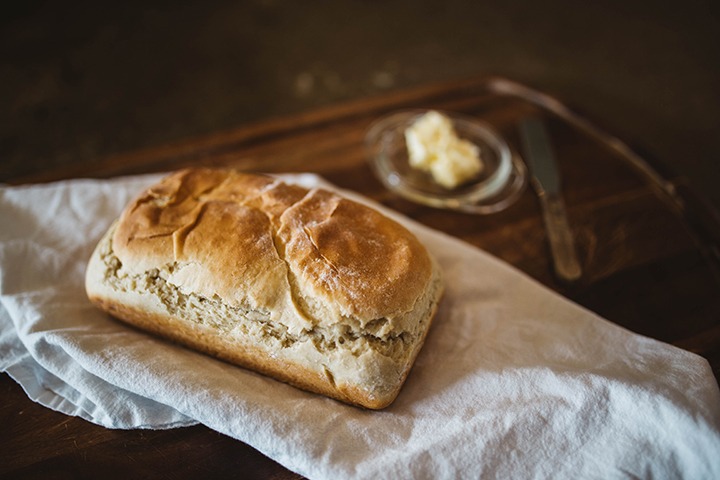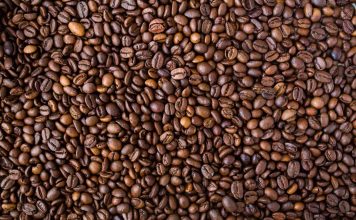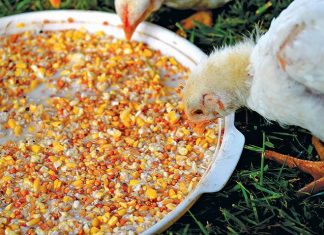 |
|
| Issue #78 • November/December, 2002 |
In today’s hurry-up, prosperous world, bread has come to mean that white, pasty stuff you buy in the store and slap together into boring, equally tasteless sandwiches. Or it’s what contains that fast-food, mystery meat burger. But, there was a time when it used to be much more.
Not so long ago, breads were eaten at nearly every meal, and still are in many third world countries. No, I’m not talking about mushy store bread, but the real thing. Full of nutrients, satisfying and comforting, good bread truly is the staff of life, being the basis for many great mealsif not the meal itself during hard times.
Nearly all breads are easy and quick to make. And they are even better if you make them yourself, especially from your own grains, ground in your kitchen. No chemicals, no additives, no fillers. (Believe it or not, I saw a loaf of bread in a store lately that had cellulose as an ingredientprocessed sawdust.)
|
To make breads even more valuable, they not only can be included in main courses, but also as desserts. Let’s look at a partial list of bread possibilities: muffins, rolls, white bread, whole wheat bread, rye bread, multi-grain bread, cornbread, popovers, corn tortillas, flour tortillas, pitas, biscuits, sweet rolls, cinnamon rolls, doughnuts, banana bread, zucchini bread, pineapple bread, hush puppies, apple fritters, hamburger and hotdog buns, pancakes, waffles, and a whole lot more.
I buy local wheat from a rancher, rye and other whole grains from an organic market. I usually grow enough corn to have cornmeal. All of these and more are ground in my kitchen, as I need them, and made into fresh breads for the table.
Now, I’m a more-than-busy person, but my baking only takes a couple of hours a week, all totaled. My “big” baking day is usually on Monday, when I bake white and whole wheat bread for the week. On other days, I’ll mix up tortillas, biscuits, corn bread, or rolls, in less time than it takes to tell. Like anything else, the more you do it, the quicker and easier it is. I can mix up a batch of biscuits from scratch in about the same time it takes to remove a roll of frozen biscuits from the freezer and place them on a cookie sheet. (Someone once gave our youngest son, David, a roll of those frozen biscuits. He brought them home, unsure of what to do with them. After leaving them on the counter until I got out of the garden, he asked how to make them, fascinated that biscuits could actually be in those little paper rolls. Well, it was hot that day, and that roll was plenty fat. David gave it a little tap and the cardboard roll exploded. KAPOW! Biscuit dough flew through the air. Some even stuck on the cupboard door. With big eyes, David declared he didn’t know storebought biscuits could explode. Maybe he’d mix up a batch of homemade biscuits, instead.)
In addition to being more nutritious and tasty than store breads (and less explosive), homemade breads are very economical. Today, the average “better” breads are around $2.69 a loaf. I can make two loaves of a far superior bread for less than a dollar, total. And that’s if I buy my flour, instead of growing my own grain or buying it from a local rancher.
Someone contemplating a self-reliant lifestyle would do well to give bread baking a serious study. Not only does it make homestead life much more satisfying, but it allows a family to save a lot of money, too.
Grains for bread making
Wheat is a commonly raised grain nationwide. The best wheat for bread making is hard wheat. Even hard wheat comes in “winter wheat”planted in the fall, over-wintering to grow and mature in the summer of the following year, “spring wheat”which is planted in the spring and harvested in the fall of the same year, red wheat, and white (or golden) wheat which is a lighter color. You’ll have to experiment to find your family’s favorite, although, all make very good bread.
|
You can easily raise wheat at home. I’ve done it a lot. And a small plot, about 10 by 100 feet will give you a bushel or more of excellent grain to grind for your table. It’s easy and fun to grow. Plant your winter wheat about six weeks before cold winter weather sets in and spring wheat when the weather is just warming up in the spring, after worries about freezing are over.
Till up your wheat plot and simply scatter wheat seed on top of the rough soil. Then rake or shallowly till the seed in so it is covered by about an inch of soil. Water well and keep evenly moist but not wet until germination takes place in about a week. Simply water as needed and wait for maturity. Birds sometimes eat maturing wheat. We’ve had good luck by putting a couple of child’s pinwheels on either end of the garden in the ground and stationing a plastic owl on a stake here and there in the maturing wheat.
The maturing wheat will get golden, with no green showing. Before it is so mature that it begins to fall from the stalk, cut your plot. The easiest and best way is to use a scythe with a grain cradle. This “grim reaper” style tool has a light frame attached to it which catches the grain stalks as they are cut off. Then you can bundle the wheat into a sheaf, tying it around the “waist” with a few straws of wheat. If you don’t have, or can’t borrow a scythe, you can cut your wheat with just about anything. I’ve seen people use hedge trimmers, string trimmers and even kitchen scissors. One tip: if you must use a power trimmer of some type, cut your wheat just a bit green so the shock will not shatter the wheat out onto the ground. Then dry it a little longer than you would otherwise.
The sheaves are then stood up in little tipis, or shocks, with one sheaf spread out on top, to shelter the grain from dew and any rain. You will know when your wheat is ready when you can take a head of wheat and roll it lightly between your fingers, and the grains easily fall out into your hand.
We create a threshing floor by laying a cheap plastic tarp out on the driveway, on a sunny, quiet day. Then we lay an old sheet out on top of that. Gently gather up your shocks of wheat and bring them to your threshing floor. A few at a time, lay them out on the clean sheet, then flail the grain from the straw with a baseball bat. Or you use a homemade flail made with two sections of old shovel handle, one a foot long, the other three feet long, with a piece of cord four inches long tied through holes drilled in the ends of each. The long section is your “handle”, the short section, your flail. Gently beat the straw, loosening all of the grain. Then, with a clean pitch fork, shake and lift off the empty straw and stack it.
Repeat until all your wheat has been threshed. Gather up your grain, which also has bits of chaff, straw, and other debris. Now wait for a windy but dry day and winnow your grain. Spread out a large container. I use one of my wash tubs. Then pour the wheat slowly from a bowl, down to your tub, letting the wind clean your grain. Usually only a couple pours will remove all dust, chaff, and debris. Your wheat is now ready to store. I use a new garbage can to protect it from insects and rodents. It is a good idea to stir your wheat every couple of days, to ensure it is completely dry; any moisture will cause your precious grain to mold. I simply stir the grain with my clean hand and arm. (It’s a wonderful feeling, too.)
|
If you have had problems with insects (weevils) in your grain, you may want to freeze your wheat, a batch at a time, before long-term storage. Usually freezing at 0° F for three days will prevent any insect problems later during storage.
Dry wheat, properly stored in a dark, airtight container, will keep perfectly for years; a perfect addition to a long-term storage pantry.
Rye is a second sister to wheat. As it is darker and stronger flavored, and with less gluten than wheat, it is used less often. But it is one of the hardiest of all grains and a good addition to your grain pantry. A small plot off the end of your wheat plot, say 10 feet by 25 feet, will provide all the rye you need for an average year. The growing and harvesting of rye is just like spring wheat.
Oats are very hardy and easily grown at home, however, there really isn’t an easy way to dehull them at home. But there is a relatively new variety of oats out which makes this a thing of the past. Naked hulled oats have no tight hull, so simply threshing them as you would other grain leaves them clean and ready to roll or grind.
I roll some of my oats for a coarser bread and for non-bread uses, such as cookies and granola. But I also grind some oats with my wheat, to use in multi-grain breads, making oat flour, instead of rolled oats.
Oats are super easy to grow at home. They are planted in the early spring, just after the cold weather moderates.
They will take a frost, but a hard freeze can damage the stand. Plant and grow as you would wheat or rye. Oats are a very good nurse crop for a new hay field. They protect the fragile, small alfalfa, clover and grass, shading it from extreme sun and heat. Then, when you harvest your oats, the hay field really takes off and grows.
Corn is a staple of my kitchen, in all forms. It is especially versatile as a bread ingredient. One first thinks of corn bread. And he often stops right there. But my corn is used for corn tortillas, in multi-grain bread, many white breads, as a crunchy crust dust for pizza dough, bread sticks, hush puppies, cornmeal mush for breakfast, tamale dough, and Indian pudding for dessert.
Corn used for meal and corn flour is mature, hard, dry corn. Cornmeal is the gritty textured ground flint corn, where corn flour is silky smooth flour, ground from dried, uncooked hominy corn, with the “skin” removed by boiling in lime water until the skin will separate from the kernel.
It doesn’t take much room to grow a patch of corn for your own cornmeal and corn flour. A dozen 20-foot rows will provide all you can use in a year. (Remember, in a survival situation, you will use much more cornmeal than you may today.) I’ve made excellent cornmeal with “leftover” second ears of sweet corn that were not used at market or for my canning needs.
Wait to harvest your corn, until the plants are totally dry and rattle in a wind. The corn itself should not give under pressure from your thumbnail. I prefer to leave it on the stalk until a dry period in late fall to make extra sure the corn is dry and avoid chances of mold.
|
Pick your ears and shuck them, removing all of the husk and silk. If you have the room, somewhere insect and rodent-proof, store your corn on the ear, as it will keep very well that way. If not, shell the corn. A hand-turned corn sheller is one old-time tool that is very handy. Unfortunately, few of us have one. I usually just twist two ears of corn together over a clean barrel or garbage can. With practice, you can shell a lot of corn this way in a few hours.
As with your other grains, be sure to stir the barrel of corn every day or two, until you are positive it is completely dry. With low-moisture corn, this is accomplished in a week’s time. Be sure. Mold spoils the whole lot.
Miscellaneous grains
There are a whole lot of grains, used by folks world-wide, other than wheat. They are tasty and very nutritious, but, unfortunately, they do not contain gluten, which makes bread rise nicely. I use many of these grains, in addition to my wheat, making a multi-grain bread. And I often make ethnic breads from these traditional grains, for variety and unique tastes. You might want to give them a try.
Millet, amaranth, barley, buckwheat, quiona, wild rice, brown rice and even “weed” seeds, such as pigweed, dock, and crab grass make excellent grains, especially in addition to wheat flour. These grains can be found at local food co-ops and wild-harvested around your homestead, in the case of “weed” seeds. As with any wild foraging, be sure of your plant to avoid problems.
Nongrain bread additions
There are many things that I often use in my daily bread making that are not “grain,” but help make tasty loaves, nonetheless. Among them are: hulled sunflower seeds, sesame seeds, poppy seeds, finely ground, dried squash and pumpkin, grated or dry powdered cheeses, powdered dried chilies, onion powder, tomato powder, ground dry beans, nuts of all kinds, acorn meal, and potatoes. I am a very causal cook, and I often experiment while baking breads. No one complains about the results either.
And of course, I use many fruits in sweet and dessert breads. These include candied mixed fruit, dehydrated cherries, cranberries, blueberries, raspberries, blackberries, apples, peaches, apricots, currents, and raisins.
Grinding your own grain
Home grinding your own flours is akin to canningso satisfying, easy and, yes, even fun. I’ve always had to fight my way to the grinder. The kids always want to turn the handle and watch the flour trickle nicely out into a bowl.
|
There are many good flour mills. Obviously, the more expensive mills grind more flour per minuteand usually finer flour on one pass throughthan do the economy models. Unfortunately, we’re not able to afford a $200-plus mill. So I bought a nice little hand-powered mill for $59, and have been very satisfied with it. It grinds all the flour for one baking of bread in 20 minutes. This includes two grindings, as one pass through the mill is not quite fine enough for my likes. I often use half-coarse flour and half the second grind, which makes a “wheat-nut” bread that we all like.
You can even use a blender, but because you can only process a cup or so at a time it will take you forever.
You will have to play around with a new mill, adjusting the grind to your likes and needs, as most are widely adjustable. Most mills will grind nearly all grains, from wheat to corn and even nuts. If you want to roll your ownoats, that isyou will need a mill that will perform this task or buy an additional rolling mill.
Why, you may say, should you bother grinding your own grain? Well, it’s like gardening: everything tastes much better fresh. (Which is better, a store-bought tomato or one fresh from the garden?) You also know for certain what’s in your flour. No chemicals, pesticides, additives, bleach, or other dubious ingredients. And fresh, home-ground flour is so much better for you than store-bought flour (even store-bought whole wheat). Processed commercial flour removes over 24 nutrients from the wheat. Home processing removes very little indeed.
Bread baking basics
Most breads include wheat flour (for its gluten content and natural sweetness which make the bread rise and have a nice texture), a small amount of sugar or honey to feed the yeast, yeast to make the bread rise, a smaller amount of salt to keep the yeast in check and develop the flavors, shortening or oil, milk or water as a liquid, and sometimes eggs to provide color and richness.
I buy my yeast in one pound sacks. It keeps perfectly good on the shelf for a year or more. Mine is gone by then. This yeast is granulated dry yeast, and is much cheaper than the little packets. In fact three packets of three, which is how they come, cost the same as my one-pound bag. Check around. You might want to share with a friend if you are new to baking.
Both the milk and eggs can be fresh or dehydrated, so you see bread truly can be the staff of life in a survival situation, where you must cook out of a long term storage pantry. All of the ingredients are very happy in a survival pantry.
|
Make sure that all ingredients are at room temperature. Bread does not like cold. Mix your dry yeast in the amount of lukewarm liquid the recipe calls for, plus a pinch of sugar or honey. This lets it get to growing and makes adding it to your dough batter much easier. Then mix your dry ingredients in a large bowl, less one cup of flour.
This little trick I learned by experience. There is no foolproof recipe for bread. In different climates, with different humidities, with different flours, you may have to add considerably less or more flour to get the right consistency to your dough. It’s always easy to add more flour to your dough as you work it. It’s impossible to take flour out of a too-stiff dough. You can, of course, add more liquid, but that’s a mess and more work than I like. It’s better to hold back that cup of flour.
Usually, your sugar, salt, and shortening are added to the hot water or milk, then the mixture is brought down to lukewarm before mixing in the flour and yeast. Again, a little trick is to add half of your flour, especially whole wheat flour, to very hot liquids and beating it well with a whisk or wooden spoon. This helps it to rise better. Let this batter cool to lukewarm, then add your yeast and, finally, the rest of your flour, a cup or so at a time.
When your dough is so stiff that you can’t use your wooden spoon, turn it out onto a clean, floured surface; a counter top, table, or bread board. Flour your hands well and begin to knead the dough. This is done by first forming a ball, then, with the heels of your hands, shove down in the center of the ball hard. With your left hand, turn the dough ball slightly, and repeat, drawing the top to the center, and shoving down hard. It’s like dancing; invigorating and rhythmic and it’s good exercise.
At first the dough will stick to your fingers. Sprinkle a bit of flour on the board and on your hands and continue kneading. Don’t be timid about adding flour. You’ll add that cup you held back, and usually more. But don’t add so much flour that your dough is stiff and unyielding or your bread will be of low qualitybut still better than store bread.
When you start, your dough will be crummy, sticky, and nearly unmanageable. After 10 minutes or so your dough will suddenly change before your eyes. And your hands. All at once, it will be shining, bouncing back from your touch. Firm, yet seeming to have a life of its own. It is now ready for setting to rise.
Grease a large bowl and place your prize dough lightly in the bowl, greasing the ball. Then lift it out and reverse the dough, so that the greased part is now the top.
I rinse a clean kitchen towel in hot water, then wring it out, placing it on top of the bowl. This seals out cool drafts and keeps the dough from drying out.
Place the bowl in a warm, draft-free spot to rise. This usually takes about an hour, but can take two or more, depending on your yeast, the weather, the mood of the loaf, or whatever. Wait for it to double in size. Many beginners can not wait and continue with their baking too early. This results in a loaf that is heavy and too dense.
|
Test the dough with two fingers, pressing lightly into the top of your dough ball. If the indentations remain for a minute, your dough is ready for the next rising.
Now’s the fun part, especially if you’ve been under a lot of stress lately. Turn the dough out onto your lightly floured kneading surface and pound it. Knead it a minute, then pound it again. This distributes the gluten and releases your stress. Baker’s Zen.
A few bread recipes require a second rising in the bowl, but most now have you divide your dough into two or more pieces and shape it to fit your bread pans (or fancy). Roll each piece of dough into a smooth, round ball, then gently pat it into the shape you desire, from bread pan to free-form shepherd’s bread or braids. It all tastes great.
Lightly grease your bread pans. If you are doing free-form breads, simply place them on a greased cookie sheet to rise and bake.
Again, cover the dough with your damp kitchen towel and set in a warm place to rise. Do not let the bread rise too far. It should rise almost double. It’s better not to let it rise all the way, than to rise too far. Don’t poke it this time, or your beautiful bread will have dimples when baked.
Preheat your oven. This is especially important for those of us who bake on a wood kitchen range. It often takes half an hour for the oven to reach 350° F, so be sure you preheat. Even a gas stove takes several minutes to reach baking temperature, and your bread will rise nicer if it is popped into a hot oven, rather than one that is in the process of heating.
So let’s give a simple bread recipe a go and see just how easy it is.
Fail-proof white bread
Ingredients:
| 1 Tbsp. dry yeast ½ cup warm water ½ tsp. honey 4 cups hot water 3 Tbsp. shortening 1 Tbsp. salt 3 Tbsp. honey 8 cups unbleached flour butter |
Stir the yeast into ½ cup warm water and add the half-teaspoon of honey. Let sit until you are ready for it.
In a large bowl, add the hot water, shortening, salt, and the rest of the honey. Stir until honey is dissolved and the shortening has melted.
Sift five cups of flour into the liquid in the large bowl and beat well with a whisk or wooden spoon. Let the mixture cool to lukewarm and add the yeast mixture. Again beat well. Add the remaining flour, one cup at a time. You want a dough that you can barely mix with a wooden spoon, held just above the spoon part.
Flour your kneading surface and dump the dough out onto the board. Flour your hands and begin kneading the dough. Add flour, as needed (no more than a half cup at a time). If it is sticky, add more flour, a bit at a time, under the dough, and on your hands. When it seems more “workable,” let it rest on the floured board while you wash out the mixing bowl with hot water. Dry it and return to your kneading.
Knead the dough ball until it feels alive and springy. Grease the bowl and rub the top of the ball in this grease, then turn it over so the top is nicely greased. Cover with a warm, damp kitchen towel and let rise in a warm place until doubled.
When the dough is ready (two finger indentations on top remain for a minute), punch it down well. Grease two bread pans and form the dough into two loaves, leaving the tops smooth and the ends neatly tucked under. Again, cover them with your kitchen towel and let rise until nearly double. Preheat your oven to 400° F. Bake at 400° F for 45 minutes until the top is nicely browned and sounds hollow when you tap it with your finger.
Remove the bread from the oven and butter the tops to soften them and give them a beautiful sheen. Remove them from the pans and let them cool (if you don’t have drooling family members hovering around begging and whining pitifully). We usually eat up a good chunk of hot bread as soon as it exits the oven.
Honey whole wheat bread
Ingredients:
| ½ cup warm water 2 Tbsp. dry yeast ½ tsp. honey 2 cups warm water 1 Tbsp. salt 2 Tbsp. honey 1 Tbsp. shortening ¼ cup chopped sunflower seeds 6 cups whole wheat flour butter |
Stir ½ cup warm water, the yeast, and ½ teaspoon honey into a cup to proof. In large bowl, add two cups of warm water, salt, 2 tablespoons of honey, and the shortening. Beat until the shortening has melted. Add the chopped sunflower seeds, then add one cup of flour at a time until you have a medium batter. Add the yeast mixture. Add flour, while beating well. Stir the thickened dough with a wooden spoon until it is ready to knead, adding more or less flour, as needed. Turn out onto a floured board and knead for ten minutes. Grease the top and place the dough in a greased bowl and cover with a warm, damp towel until it rises to double in size. You may now punch down the dough and divide it into two loaves, or punch down the dough, and let it rise a second time for a finer loaf.
Place the loaves in greased bread pans and let rise until nearly doubled. Preheat your oven to 350° F.
Bake the bread about 45 minutes until tops are golden and sound hollow when tapped with a finger. When done, butter the tops and sprinkle with chopped sunflower seeds or sesame seeds, if desired.
Okay, we’ve made some traditional easy or everyday breads. Pretty darned good, huh? These are some of my everyday recipes. Remember, you can easily perk them up by making one “loaf” into a pan of rolls by making golf ball sized balls and placing them side by side in a greased 8-inch by 8-inch pan. Or you can divide one loaf of dough into thirds and make three dough snakes and braid them beautifully, pinching and tucking the ends under. The braids are baked on a greased cookie sheet. I often make a glaze, using one teaspoon of egg white and one tablespoon of water mixed well and brushed on the risen loaves, then sprinkle poppy or sesame seeds on top. Bake as usual. They come out shining and crisp-crusted.
Besides these basic breads, I usually make several other everyday breads. The most common three in the Clay kitchen are spoon rolls, tortillas (flour and corn), and biscuits. All are super easy and fast to make. And they taste great too. Here are my recipes for you to try.
Half-time spoon rolls
Ingredients:
| 1 Tbsp. dry yeast ¼ cup warm water pinch of sugar ¾ cup warm water ¼ cup shortening ¼ cup sugar 1 tsp. salt ½ cup cold water 1 egg 3-½ cups unbleached flour butter |
Dissolve the yeast in ¼ cup warm water. Add a pinch of the sugar and stir well. In mixing bowl, add ¾ cup of very warm water, shortening, sugar and salt. Mix well until the shortening melts. Cool with ½ cup cold water and one egg. Mix well. When lukewarm, add the yeast mixture, then stir in the flour, a little at a time. The dough will be very sticky. You do not knead this dough.
Cover and let rise in a bowl till doubled. Grease muffin tins and using a greased ice cream scoop, knock down the risen dough and spoon one scoopful into each cup of the muffin tin. Let it rise, again, until they double in size and bake about 10 minutes in a 375° F oven. Butter the tops and serve hot. Truly great. I also use this recipe for my hamburger and hot dog buns, shaping them on a greased cookie tin. Hint: make ’em a little smaller than you think you should, as they get big during the rising and baking.
Basic baking powder biscuits
Ingredients:
| 2 cups unbleached or whole wheat flour 2 tsp. baking powder 1 tsp. salt ¼ cup shortening milk |
Sift the dry ingredients together in mixing bowl. Add the shortening and mix it in with a fork, until pieces of the mixture are the size of small peas. Add milk until you have a moist, but not sticky dough. Turn out onto floured surface and knead lightly. Pat down to about half-an-inch thick. Cut the biscuits out of this. (I use a greased canning jar ring for this.) Place the biscuits on a greased cookie sheet touching each other in a rectangular pattern. Bake at 400° F for about 10 minutes or until the tops are lightly browned.
You may add ½ cup grated cheddar cheese for cheese biscuits, topping the biscuits with more grated cheese after they have risen in the oven for a crispy cheezie treat.
Served hot with butter and homemade jam, you can’t beat these easy biscuits.
Flour tortillas
Ingredients:
| 2 cups unbleached or whole wheat flour 1 tsp. baking powder 1 tsp. salt 1 Tbsp. shortening ¾ cup warm water |
In mixing bowl, stir together dry ingredients. Mix in the shortening until the mixture resembles cornmeal. Add 1/2-cup water and mix. Add the rest of the water as needed. You want a dough that is moist, yet not sticky. Let the dough rest for fifteen minutes, covered with a moist kitchen towel. Divide the dough into 12 equal portions. Shape into balls and on a lightly floured surface, roll each ball into a thin round. You may trim them, using a saucer for a pattern. I don’t bother. My uneven tortillas look nice and homey, and taste just fine. Bake them on an ungreased cast iron griddle on the stovetop over medium heat until lightly browned for about 1½ minutes. Turn and bake on the other side. Serve warm. Like everything else, homemade tortillas sure beat “store” tortillas. They are actually tender and tasty. If you want to use tortillas for burritos, wrap the filling with warm tortillas or they will break, reheating them if necessary before filling.
Corn tortillas
Ingredients:
| 2 cups masa harina de maize (corn flour) 1 tsp. salt 1 tsp. onion powder 1 tsp. chili powder (made from chilies only, not mixed spices) 1 cup water |
Combine masa, salt, spices, and water in a mixing bowl and mix with fork until dough is moist, but not sticky. Let stand for ten minutes. Divide the dough into 12 balls. Using a tortilla press or a pie pan, press each ball flat, between sheets of waxed paper or plastic. I further roll each tortilla out with a rolling pin, keeping it in the waxed paper, as we like thin tortillas. Carefully pull off the top sheet, then turn the tortilla out into your hand and pull off the other sheet of waxed paper. Bake on a hot griddle (I like cast iron best) on the stovetop until slightly brown, then gently turn and bake the other side.
Corn tortillas are great, served warm with stews, soups, or even with jam for breakfast. Or you can make your own enchiladas, tacos, or nacho chips. One of our favorites is deep fried “raw” corn tortillas, served with homemade salsa, mixed with grated, melted cheese as a dip. There are seldom any leftovers. When you want to make nacho chips, simply stack your tortillas and cut them with a sharp knife, as you would a pizzaright through the entire stack at once. Then deep fry several at a time in hot oil. Salt, if desired, as soon as you remove from the grease to drain on paper towels.
Enchiladas are easy to make with homemade corn tortillas. Bake them. Then, while warm, dip them in enchilada sauce, fill, and roll up while warm. If they are cold, they’ll break up. No problem. Just reheat and dip or even make a layered enchilada casserole instead.
Breakfast and dessert breads
Besides the normal breakfast breads, pancakes, biscuits, waffles or corn bread, other breakfast breads are easy and fun to make and serve. One of my favorites is to use either biscuit dough or half-time spoon roll dough (with a little extra flour added so you can knead it) and make cinnamon sweet rolls or sticky buns. Instead of making biscuits or rolls, roll the dough out in a rectangle, about half an inch thick. Then, with your fingers, rub butter over the entire surface. For cinnamon rolls, mix ½ cup of sugar with a teaspoon of cinnamon and sprinkle liberally on the surface. For sticky buns, mix a cup of brown sugar with a teaspoon of cinnamon. Spread this out on your dough. Then add a handful of chopped nuts.
Roll up the dough carefully, jelly roll-style. Pinch off the ends and seam. With a sharp knife, slice into one-inch (biscuit dough) or two inch (half-time spoon roll dough) slices and place in a greased 8-inch by 8-inch cake pan. Bake at 350° F until the tops are nicely browned. All the preparation takes about 20 minutes. I told you it was easy.
One of our family favorites is Mom’s version of the old-time breakfast bread, Sally Lunn. Now there are about a dozen or more recipes titled Sally Lunn, all quite different. But I like Mom’s best. And it is very quick to put together.
Sally Lunn
Ingredients for bread:
| 2 cups unbleached flour 3 tsp. baking powder ¾ tsp. salt 1/3 cup shortening 1/3 cup sugar 1 egg, beaten 2/3 cup milk |
Ingredients for topping:
| ½ cup brown sugar 1 tsp. cinnamon 1 Tbsp. butter |
Sift the flour, baking powder and salt together. Cream the shortening and sugar together. Add the beaten egg. Next add the milk and mix into dry ingredients. Stir just to moisten. Turn into greased 8-inch by 8-inch cake pan. Make the topping by mixing those ingredients together then sprinkle it over the batter. Bake at 400° F for 20 minutes or until done. Serve with homemade butter and a glass of icy cold milk from that cow or goat in your pasture, and you are there!
We also like this as a dessert, with a bowl of sliced fresh strawberries, with sugar or a sugar substitute on them (Bob’s diabetic, so we do a lot of sugar substituting), and we pour this over the Sally Lunn, top it all with fresh whipped cream. Not bad at all.
Another old-time bread dessert is bread pudding. I know this sounds pretty disgusting to the uninitiated. But it is really good, especially served hot on a cold day. And it’s a good way to get rid of those chunks of old bread.
Bread pudding
Heat 3 cups of milk, add ¼ cup melted butter, ½ cup sugar, and 4 cups of bread cubes (torn bits of bread, bite-sized). Beat 3 eggs, and add ¼ teaspoon salt, 1 teaspoon vanilla, and a ¼ teaspoon nutmeg. Stir all together. Add a handful of raisins or other dehydrated fruit. Pour into buttered dish and bake at 350° for about 55 minutes until set. Serve with sweetened milk or whipped cream. Mom makes a sauce of two cups of powdered sugar, a stick of butter, one teaspoon of vanilla, and a ¼ teaspoon of nutmeg, which she creams together. She puts a spoonful of this on each serving of pudding while it’s hot. The sauce melts enticingly down the sides to blend with the whipped cream. Did I say we’re all in need of a diet? I’ll just go out and pull weeds for another hour.
I could go on about breads for another 500 pages, but you get the picture. They are so easy to bake, super tasty, and very versatile. I hope you’ll all join me today and mix up a batch of one of these favorites or maybe one of your own.





















